Leadership, Management, and Operations: Tesco's Strategies Analysis
VerifiedAdded on 2023/06/05
|12
|3695
|365
Report
AI Summary
This report provides an analysis of leadership and management operations within Tesco, a global grocery and merchandise retailer. It explores the roles and characteristics of leaders and managers, highlighting their differences and functions in various situational contexts. The report examines various management theories such as Classical Management Theory, Contingency Theory, and Management by Objective Theory, evaluating their strengths and weaknesses in relation to Tesco's operational practices. It further discusses key operational functions, the roles of managers, and approaches to operations management, including business procedure redesign and lean manufacturing. The analysis also considers the impact of external business environment factors on decision-making and suggests improvements for operational efficiencies using appropriate leadership and administration approaches. The report concludes with recommendations for future enhancements to be implemented by the organization, emphasizing the importance of effective leadership and management strategies for achieving better outcomes.
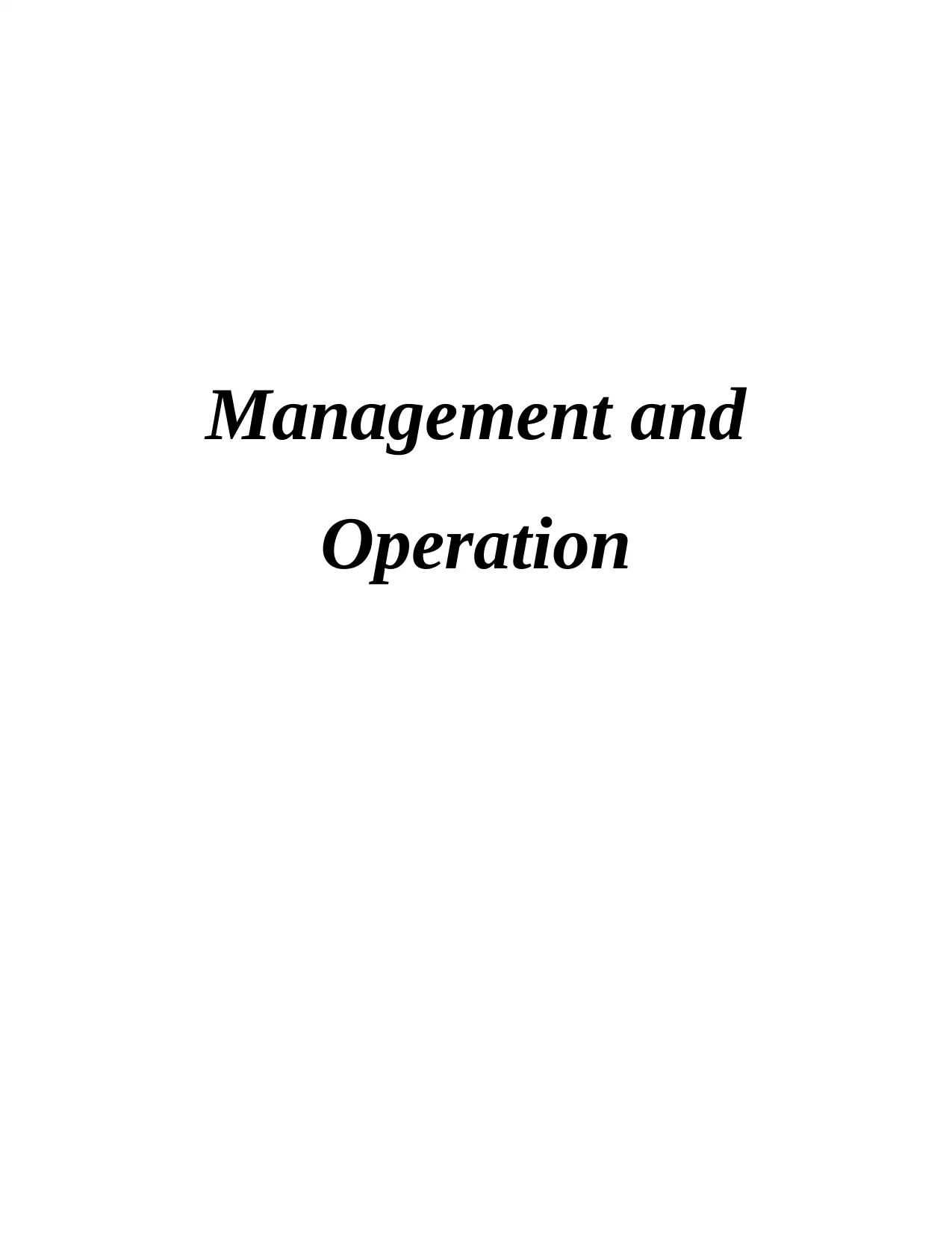
Management and
Operation
Operation
Paraphrase This Document
Need a fresh take? Get an instant paraphrase of this document with our AI Paraphraser
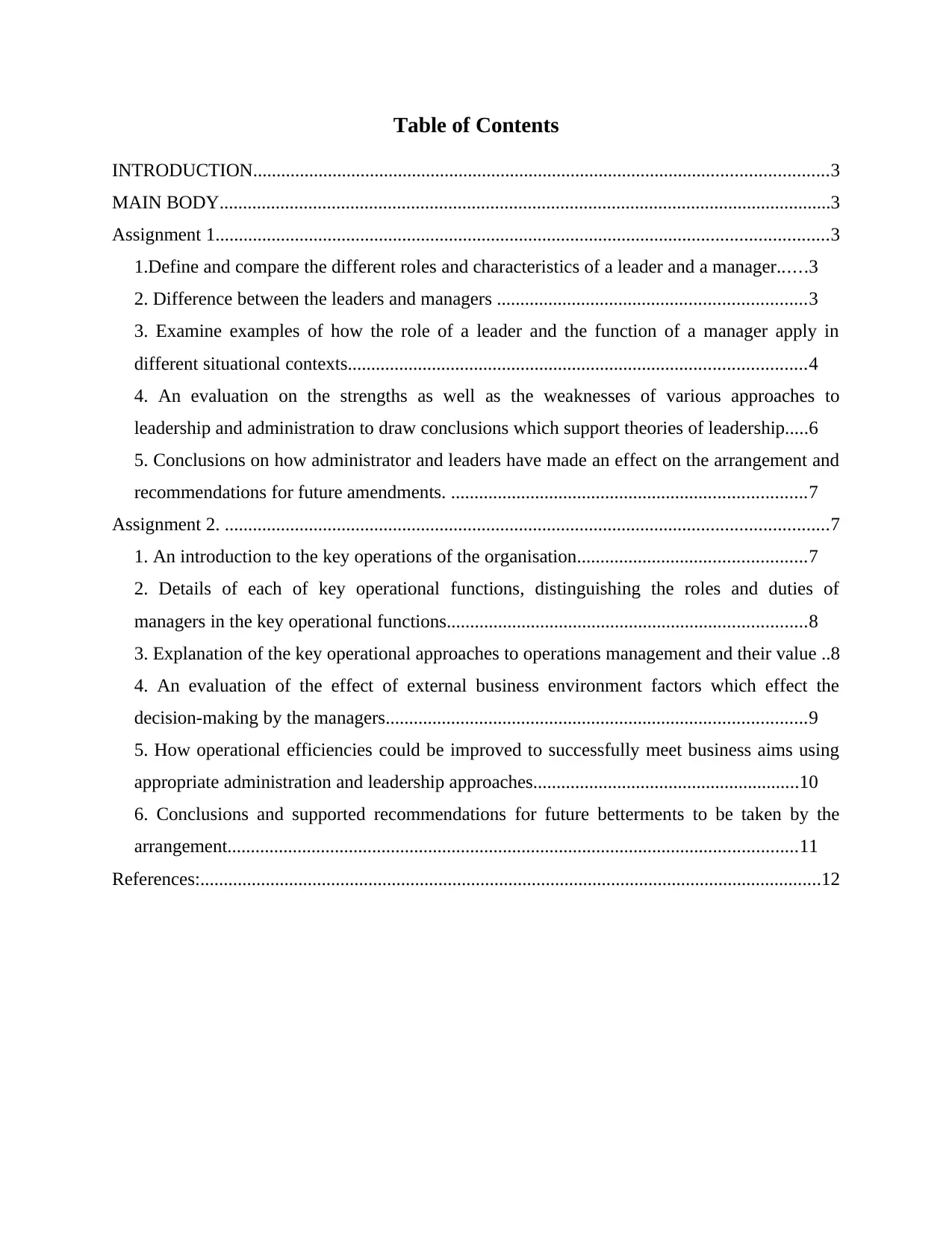
Table of Contents
INTRODUCTION...........................................................................................................................3
MAIN BODY...................................................................................................................................3
Assignment 1...................................................................................................................................3
1.Define and compare the different roles and characteristics of a leader and a manager......3
2. Difference between the leaders and managers ..................................................................3
3. Examine examples of how the role of a leader and the function of a manager apply in
different situational contexts..................................................................................................4
4. An evaluation on the strengths as well as the weaknesses of various approaches to
leadership and administration to draw conclusions which support theories of leadership.....6
5. Conclusions on how administrator and leaders have made an effect on the arrangement and
recommendations for future amendments. ............................................................................7
Assignment 2. .................................................................................................................................7
1. An introduction to the key operations of the organisation.................................................7
2. Details of each of key operational functions, distinguishing the roles and duties of
managers in the key operational functions.............................................................................8
3. Explanation of the key operational approaches to operations management and their value ..8
4. An evaluation of the effect of external business environment factors which effect the
decision-making by the managers..........................................................................................9
5. How operational efficiencies could be improved to successfully meet business aims using
appropriate administration and leadership approaches.........................................................10
6. Conclusions and supported recommendations for future betterments to be taken by the
arrangement..........................................................................................................................11
References:.....................................................................................................................................12
INTRODUCTION...........................................................................................................................3
MAIN BODY...................................................................................................................................3
Assignment 1...................................................................................................................................3
1.Define and compare the different roles and characteristics of a leader and a manager......3
2. Difference between the leaders and managers ..................................................................3
3. Examine examples of how the role of a leader and the function of a manager apply in
different situational contexts..................................................................................................4
4. An evaluation on the strengths as well as the weaknesses of various approaches to
leadership and administration to draw conclusions which support theories of leadership.....6
5. Conclusions on how administrator and leaders have made an effect on the arrangement and
recommendations for future amendments. ............................................................................7
Assignment 2. .................................................................................................................................7
1. An introduction to the key operations of the organisation.................................................7
2. Details of each of key operational functions, distinguishing the roles and duties of
managers in the key operational functions.............................................................................8
3. Explanation of the key operational approaches to operations management and their value ..8
4. An evaluation of the effect of external business environment factors which effect the
decision-making by the managers..........................................................................................9
5. How operational efficiencies could be improved to successfully meet business aims using
appropriate administration and leadership approaches.........................................................10
6. Conclusions and supported recommendations for future betterments to be taken by the
arrangement..........................................................................................................................11
References:.....................................................................................................................................12
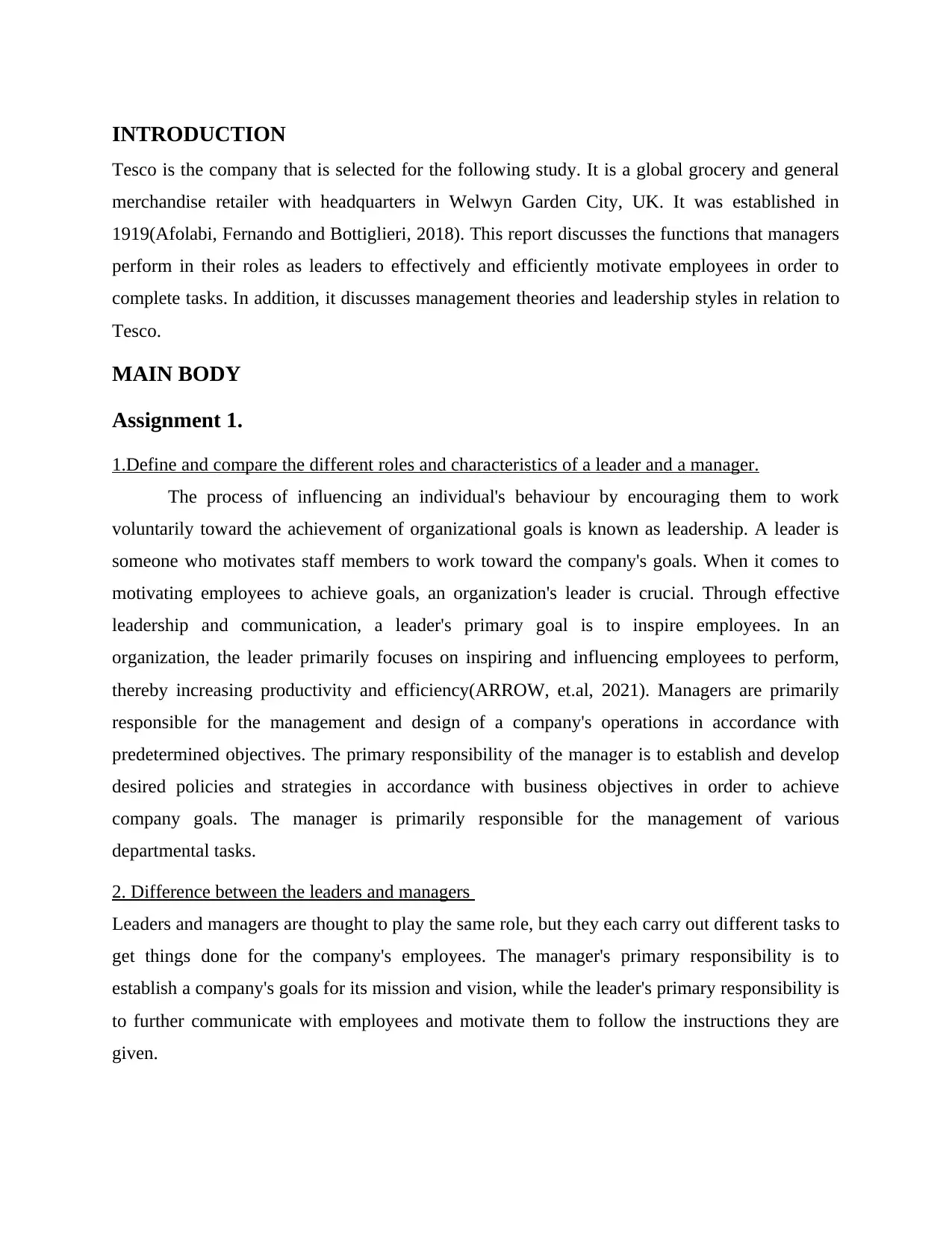
INTRODUCTION
Tesco is the company that is selected for the following study. It is a global grocery and general
merchandise retailer with headquarters in Welwyn Garden City, UK. It was established in
1919(Afolabi, Fernando and Bottiglieri, 2018). This report discusses the functions that managers
perform in their roles as leaders to effectively and efficiently motivate employees in order to
complete tasks. In addition, it discusses management theories and leadership styles in relation to
Tesco.
MAIN BODY
Assignment 1.
1.Define and compare the different roles and characteristics of a leader and a manager.
The process of influencing an individual's behaviour by encouraging them to work
voluntarily toward the achievement of organizational goals is known as leadership. A leader is
someone who motivates staff members to work toward the company's goals. When it comes to
motivating employees to achieve goals, an organization's leader is crucial. Through effective
leadership and communication, a leader's primary goal is to inspire employees. In an
organization, the leader primarily focuses on inspiring and influencing employees to perform,
thereby increasing productivity and efficiency(ARROW, et.al, 2021). Managers are primarily
responsible for the management and design of a company's operations in accordance with
predetermined objectives. The primary responsibility of the manager is to establish and develop
desired policies and strategies in accordance with business objectives in order to achieve
company goals. The manager is primarily responsible for the management of various
departmental tasks.
2. Difference between the leaders and managers
Leaders and managers are thought to play the same role, but they each carry out different tasks to
get things done for the company's employees. The manager's primary responsibility is to
establish a company's goals for its mission and vision, while the leader's primary responsibility is
to further communicate with employees and motivate them to follow the instructions they are
given.
Tesco is the company that is selected for the following study. It is a global grocery and general
merchandise retailer with headquarters in Welwyn Garden City, UK. It was established in
1919(Afolabi, Fernando and Bottiglieri, 2018). This report discusses the functions that managers
perform in their roles as leaders to effectively and efficiently motivate employees in order to
complete tasks. In addition, it discusses management theories and leadership styles in relation to
Tesco.
MAIN BODY
Assignment 1.
1.Define and compare the different roles and characteristics of a leader and a manager.
The process of influencing an individual's behaviour by encouraging them to work
voluntarily toward the achievement of organizational goals is known as leadership. A leader is
someone who motivates staff members to work toward the company's goals. When it comes to
motivating employees to achieve goals, an organization's leader is crucial. Through effective
leadership and communication, a leader's primary goal is to inspire employees. In an
organization, the leader primarily focuses on inspiring and influencing employees to perform,
thereby increasing productivity and efficiency(ARROW, et.al, 2021). Managers are primarily
responsible for the management and design of a company's operations in accordance with
predetermined objectives. The primary responsibility of the manager is to establish and develop
desired policies and strategies in accordance with business objectives in order to achieve
company goals. The manager is primarily responsible for the management of various
departmental tasks.
2. Difference between the leaders and managers
Leaders and managers are thought to play the same role, but they each carry out different tasks to
get things done for the company's employees. The manager's primary responsibility is to
establish a company's goals for its mission and vision, while the leader's primary responsibility is
to further communicate with employees and motivate them to follow the instructions they are
given.
⊘ This is a preview!⊘
Do you want full access?
Subscribe today to unlock all pages.

Trusted by 1+ million students worldwide
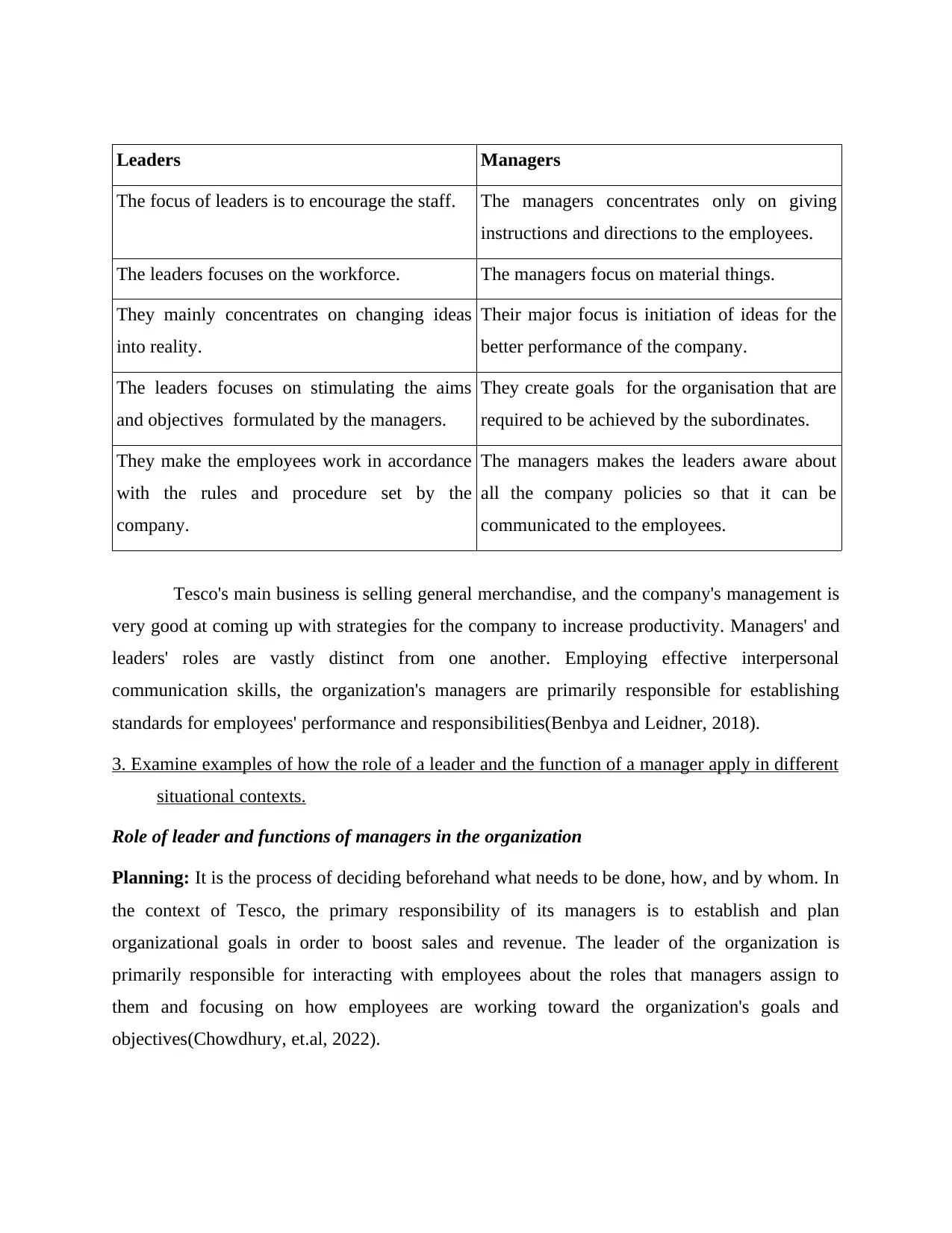
Leaders Managers
The focus of leaders is to encourage the staff. The managers concentrates only on giving
instructions and directions to the employees.
The leaders focuses on the workforce. The managers focus on material things.
They mainly concentrates on changing ideas
into reality.
Their major focus is initiation of ideas for the
better performance of the company.
The leaders focuses on stimulating the aims
and objectives formulated by the managers.
They create goals for the organisation that are
required to be achieved by the subordinates.
They make the employees work in accordance
with the rules and procedure set by the
company.
The managers makes the leaders aware about
all the company policies so that it can be
communicated to the employees.
Tesco's main business is selling general merchandise, and the company's management is
very good at coming up with strategies for the company to increase productivity. Managers' and
leaders' roles are vastly distinct from one another. Employing effective interpersonal
communication skills, the organization's managers are primarily responsible for establishing
standards for employees' performance and responsibilities(Benbya and Leidner, 2018).
3. Examine examples of how the role of a leader and the function of a manager apply in different
situational contexts.
Role of leader and functions of managers in the organization
Planning: It is the process of deciding beforehand what needs to be done, how, and by whom. In
the context of Tesco, the primary responsibility of its managers is to establish and plan
organizational goals in order to boost sales and revenue. The leader of the organization is
primarily responsible for interacting with employees about the roles that managers assign to
them and focusing on how employees are working toward the organization's goals and
objectives(Chowdhury, et.al, 2022).
The focus of leaders is to encourage the staff. The managers concentrates only on giving
instructions and directions to the employees.
The leaders focuses on the workforce. The managers focus on material things.
They mainly concentrates on changing ideas
into reality.
Their major focus is initiation of ideas for the
better performance of the company.
The leaders focuses on stimulating the aims
and objectives formulated by the managers.
They create goals for the organisation that are
required to be achieved by the subordinates.
They make the employees work in accordance
with the rules and procedure set by the
company.
The managers makes the leaders aware about
all the company policies so that it can be
communicated to the employees.
Tesco's main business is selling general merchandise, and the company's management is
very good at coming up with strategies for the company to increase productivity. Managers' and
leaders' roles are vastly distinct from one another. Employing effective interpersonal
communication skills, the organization's managers are primarily responsible for establishing
standards for employees' performance and responsibilities(Benbya and Leidner, 2018).
3. Examine examples of how the role of a leader and the function of a manager apply in different
situational contexts.
Role of leader and functions of managers in the organization
Planning: It is the process of deciding beforehand what needs to be done, how, and by whom. In
the context of Tesco, the primary responsibility of its managers is to establish and plan
organizational goals in order to boost sales and revenue. The leader of the organization is
primarily responsible for interacting with employees about the roles that managers assign to
them and focusing on how employees are working toward the organization's goals and
objectives(Chowdhury, et.al, 2022).
Paraphrase This Document
Need a fresh take? Get an instant paraphrase of this document with our AI Paraphraser
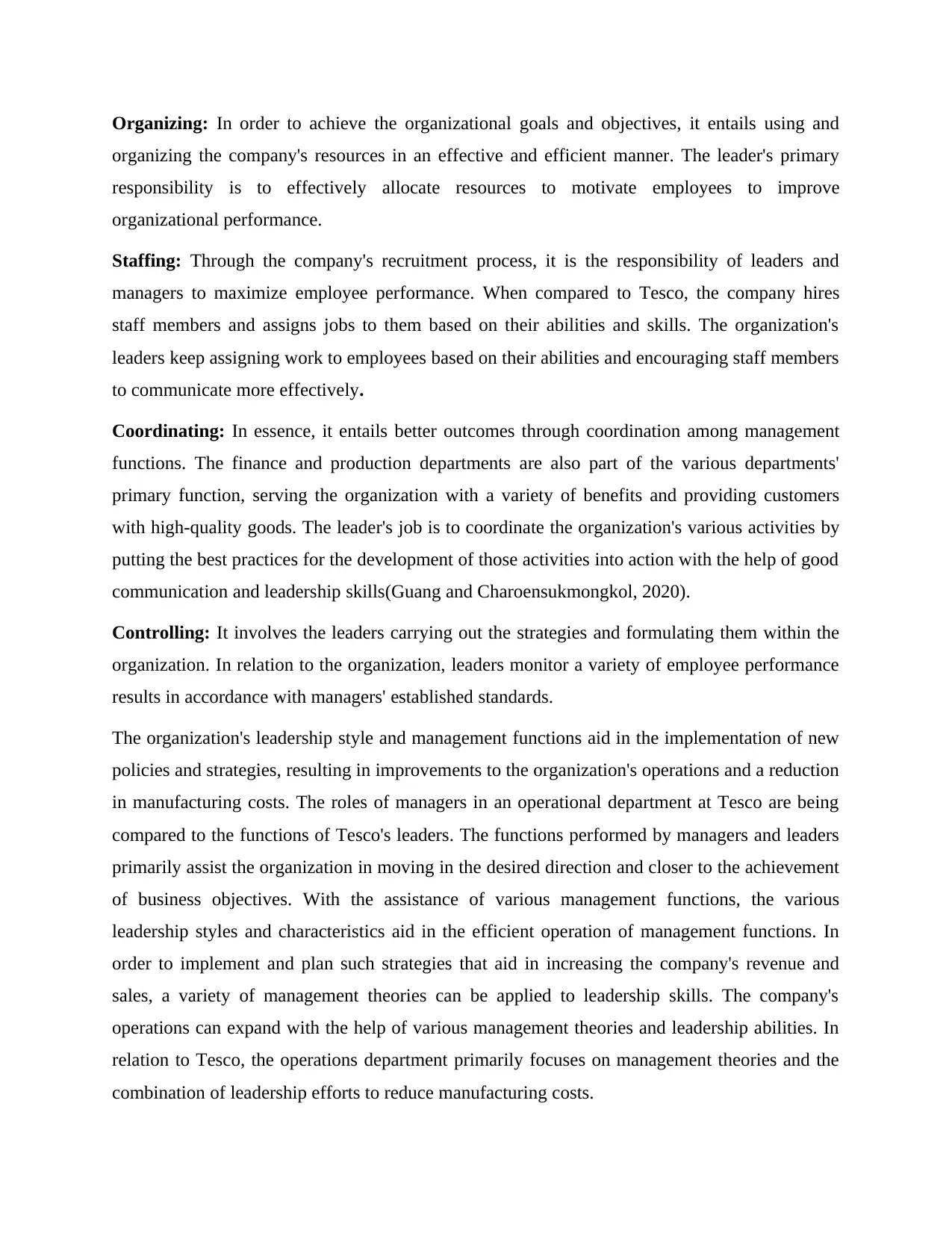
Organizing: In order to achieve the organizational goals and objectives, it entails using and
organizing the company's resources in an effective and efficient manner. The leader's primary
responsibility is to effectively allocate resources to motivate employees to improve
organizational performance.
Staffing: Through the company's recruitment process, it is the responsibility of leaders and
managers to maximize employee performance. When compared to Tesco, the company hires
staff members and assigns jobs to them based on their abilities and skills. The organization's
leaders keep assigning work to employees based on their abilities and encouraging staff members
to communicate more effectively.
Coordinating: In essence, it entails better outcomes through coordination among management
functions. The finance and production departments are also part of the various departments'
primary function, serving the organization with a variety of benefits and providing customers
with high-quality goods. The leader's job is to coordinate the organization's various activities by
putting the best practices for the development of those activities into action with the help of good
communication and leadership skills(Guang and Charoensukmongkol, 2020).
Controlling: It involves the leaders carrying out the strategies and formulating them within the
organization. In relation to the organization, leaders monitor a variety of employee performance
results in accordance with managers' established standards.
The organization's leadership style and management functions aid in the implementation of new
policies and strategies, resulting in improvements to the organization's operations and a reduction
in manufacturing costs. The roles of managers in an operational department at Tesco are being
compared to the functions of Tesco's leaders. The functions performed by managers and leaders
primarily assist the organization in moving in the desired direction and closer to the achievement
of business objectives. With the assistance of various management functions, the various
leadership styles and characteristics aid in the efficient operation of management functions. In
order to implement and plan such strategies that aid in increasing the company's revenue and
sales, a variety of management theories can be applied to leadership skills. The company's
operations can expand with the help of various management theories and leadership abilities. In
relation to Tesco, the operations department primarily focuses on management theories and the
combination of leadership efforts to reduce manufacturing costs.
organizing the company's resources in an effective and efficient manner. The leader's primary
responsibility is to effectively allocate resources to motivate employees to improve
organizational performance.
Staffing: Through the company's recruitment process, it is the responsibility of leaders and
managers to maximize employee performance. When compared to Tesco, the company hires
staff members and assigns jobs to them based on their abilities and skills. The organization's
leaders keep assigning work to employees based on their abilities and encouraging staff members
to communicate more effectively.
Coordinating: In essence, it entails better outcomes through coordination among management
functions. The finance and production departments are also part of the various departments'
primary function, serving the organization with a variety of benefits and providing customers
with high-quality goods. The leader's job is to coordinate the organization's various activities by
putting the best practices for the development of those activities into action with the help of good
communication and leadership skills(Guang and Charoensukmongkol, 2020).
Controlling: It involves the leaders carrying out the strategies and formulating them within the
organization. In relation to the organization, leaders monitor a variety of employee performance
results in accordance with managers' established standards.
The organization's leadership style and management functions aid in the implementation of new
policies and strategies, resulting in improvements to the organization's operations and a reduction
in manufacturing costs. The roles of managers in an operational department at Tesco are being
compared to the functions of Tesco's leaders. The functions performed by managers and leaders
primarily assist the organization in moving in the desired direction and closer to the achievement
of business objectives. With the assistance of various management functions, the various
leadership styles and characteristics aid in the efficient operation of management functions. In
order to implement and plan such strategies that aid in increasing the company's revenue and
sales, a variety of management theories can be applied to leadership skills. The company's
operations can expand with the help of various management theories and leadership abilities. In
relation to Tesco, the operations department primarily focuses on management theories and the
combination of leadership efforts to reduce manufacturing costs.
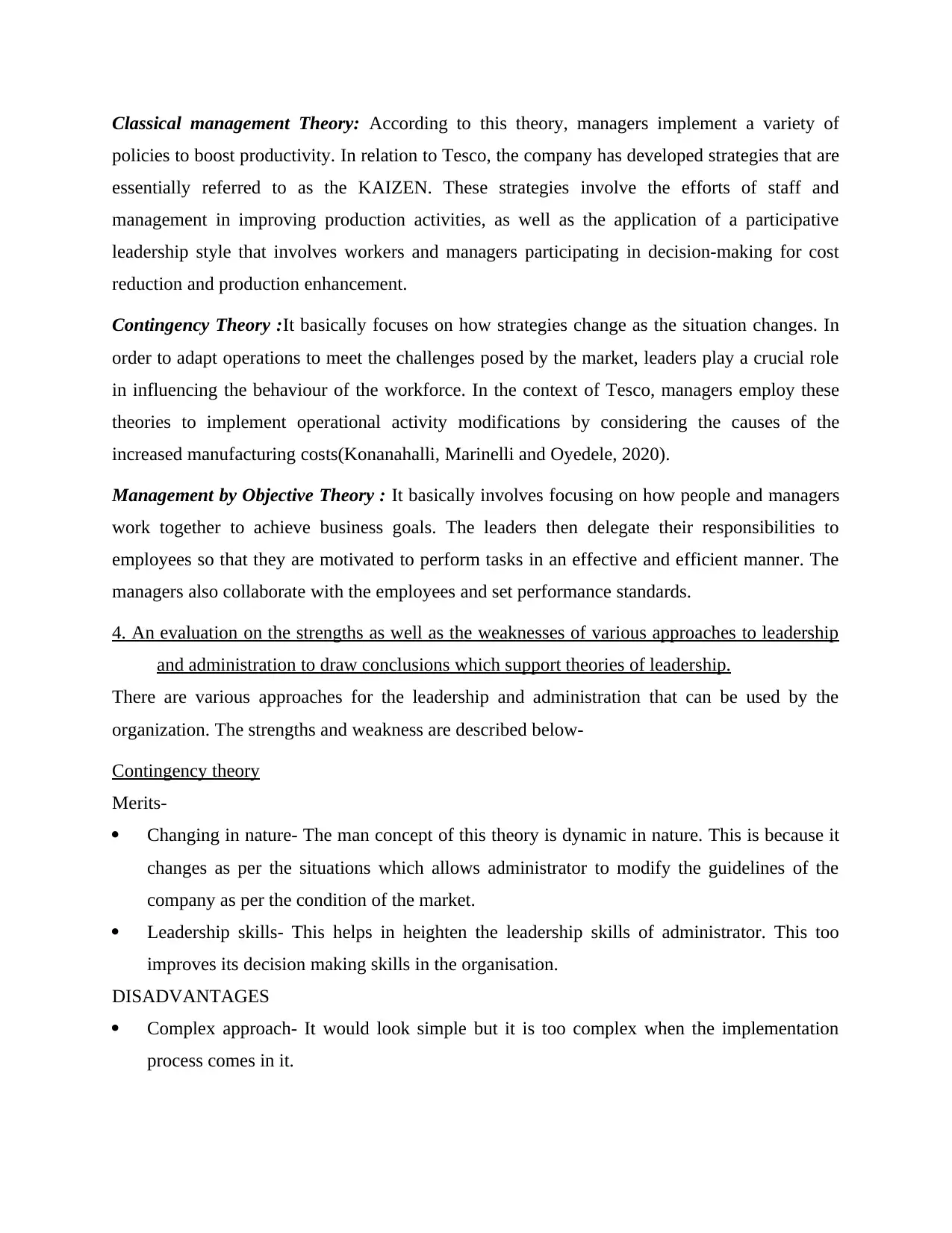
Classical management Theory: According to this theory, managers implement a variety of
policies to boost productivity. In relation to Tesco, the company has developed strategies that are
essentially referred to as the KAIZEN. These strategies involve the efforts of staff and
management in improving production activities, as well as the application of a participative
leadership style that involves workers and managers participating in decision-making for cost
reduction and production enhancement.
Contingency Theory :It basically focuses on how strategies change as the situation changes. In
order to adapt operations to meet the challenges posed by the market, leaders play a crucial role
in influencing the behaviour of the workforce. In the context of Tesco, managers employ these
theories to implement operational activity modifications by considering the causes of the
increased manufacturing costs(Konanahalli, Marinelli and Oyedele, 2020).
Management by Objective Theory : It basically involves focusing on how people and managers
work together to achieve business goals. The leaders then delegate their responsibilities to
employees so that they are motivated to perform tasks in an effective and efficient manner. The
managers also collaborate with the employees and set performance standards.
4. An evaluation on the strengths as well as the weaknesses of various approaches to leadership
and administration to draw conclusions which support theories of leadership.
There are various approaches for the leadership and administration that can be used by the
organization. The strengths and weakness are described below-
Contingency theory
Merits-
Changing in nature- The man concept of this theory is dynamic in nature. This is because it
changes as per the situations which allows administrator to modify the guidelines of the
company as per the condition of the market.
Leadership skills- This helps in heighten the leadership skills of administrator. This too
improves its decision making skills in the organisation.
DISADVANTAGES
Complex approach- It would look simple but it is too complex when the implementation
process comes in it.
policies to boost productivity. In relation to Tesco, the company has developed strategies that are
essentially referred to as the KAIZEN. These strategies involve the efforts of staff and
management in improving production activities, as well as the application of a participative
leadership style that involves workers and managers participating in decision-making for cost
reduction and production enhancement.
Contingency Theory :It basically focuses on how strategies change as the situation changes. In
order to adapt operations to meet the challenges posed by the market, leaders play a crucial role
in influencing the behaviour of the workforce. In the context of Tesco, managers employ these
theories to implement operational activity modifications by considering the causes of the
increased manufacturing costs(Konanahalli, Marinelli and Oyedele, 2020).
Management by Objective Theory : It basically involves focusing on how people and managers
work together to achieve business goals. The leaders then delegate their responsibilities to
employees so that they are motivated to perform tasks in an effective and efficient manner. The
managers also collaborate with the employees and set performance standards.
4. An evaluation on the strengths as well as the weaknesses of various approaches to leadership
and administration to draw conclusions which support theories of leadership.
There are various approaches for the leadership and administration that can be used by the
organization. The strengths and weakness are described below-
Contingency theory
Merits-
Changing in nature- The man concept of this theory is dynamic in nature. This is because it
changes as per the situations which allows administrator to modify the guidelines of the
company as per the condition of the market.
Leadership skills- This helps in heighten the leadership skills of administrator. This too
improves its decision making skills in the organisation.
DISADVANTAGES
Complex approach- It would look simple but it is too complex when the implementation
process comes in it.
⊘ This is a preview!⊘
Do you want full access?
Subscribe today to unlock all pages.

Trusted by 1+ million students worldwide
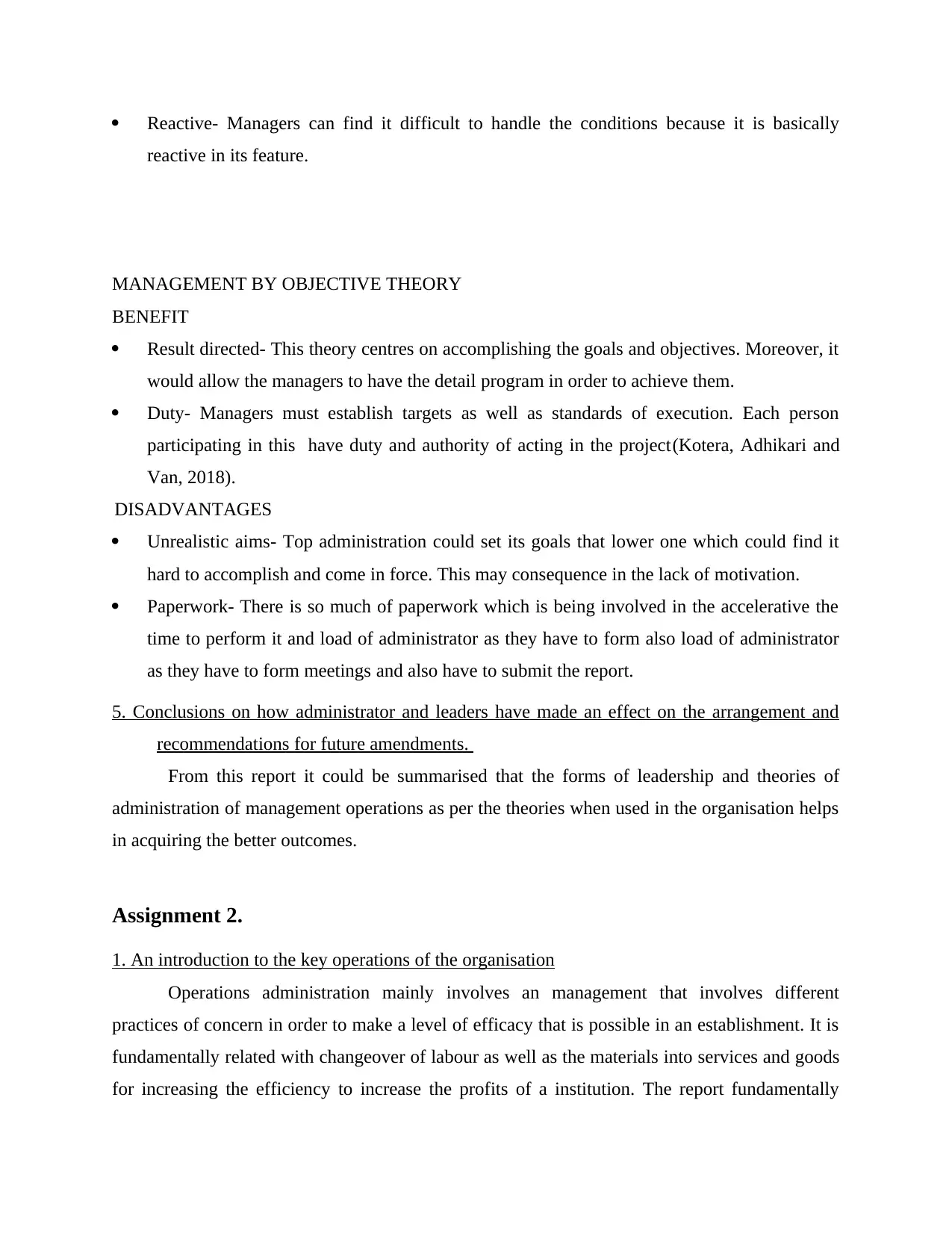
Reactive- Managers can find it difficult to handle the conditions because it is basically
reactive in its feature.
MANAGEMENT BY OBJECTIVE THEORY
BENEFIT
Result directed- This theory centres on accomplishing the goals and objectives. Moreover, it
would allow the managers to have the detail program in order to achieve them.
Duty- Managers must establish targets as well as standards of execution. Each person
participating in this have duty and authority of acting in the project(Kotera, Adhikari and
Van, 2018).
DISADVANTAGES
Unrealistic aims- Top administration could set its goals that lower one which could find it
hard to accomplish and come in force. This may consequence in the lack of motivation.
Paperwork- There is so much of paperwork which is being involved in the accelerative the
time to perform it and load of administrator as they have to form also load of administrator
as they have to form meetings and also have to submit the report.
5. Conclusions on how administrator and leaders have made an effect on the arrangement and
recommendations for future amendments.
From this report it could be summarised that the forms of leadership and theories of
administration of management operations as per the theories when used in the organisation helps
in acquiring the better outcomes.
Assignment 2.
1. An introduction to the key operations of the organisation
Operations administration mainly involves an management that involves different
practices of concern in order to make a level of efficacy that is possible in an establishment. It is
fundamentally related with changeover of labour as well as the materials into services and goods
for increasing the efficiency to increase the profits of a institution. The report fundamentally
reactive in its feature.
MANAGEMENT BY OBJECTIVE THEORY
BENEFIT
Result directed- This theory centres on accomplishing the goals and objectives. Moreover, it
would allow the managers to have the detail program in order to achieve them.
Duty- Managers must establish targets as well as standards of execution. Each person
participating in this have duty and authority of acting in the project(Kotera, Adhikari and
Van, 2018).
DISADVANTAGES
Unrealistic aims- Top administration could set its goals that lower one which could find it
hard to accomplish and come in force. This may consequence in the lack of motivation.
Paperwork- There is so much of paperwork which is being involved in the accelerative the
time to perform it and load of administrator as they have to form also load of administrator
as they have to form meetings and also have to submit the report.
5. Conclusions on how administrator and leaders have made an effect on the arrangement and
recommendations for future amendments.
From this report it could be summarised that the forms of leadership and theories of
administration of management operations as per the theories when used in the organisation helps
in acquiring the better outcomes.
Assignment 2.
1. An introduction to the key operations of the organisation
Operations administration mainly involves an management that involves different
practices of concern in order to make a level of efficacy that is possible in an establishment. It is
fundamentally related with changeover of labour as well as the materials into services and goods
for increasing the efficiency to increase the profits of a institution. The report fundamentally
Paraphrase This Document
Need a fresh take? Get an instant paraphrase of this document with our AI Paraphraser
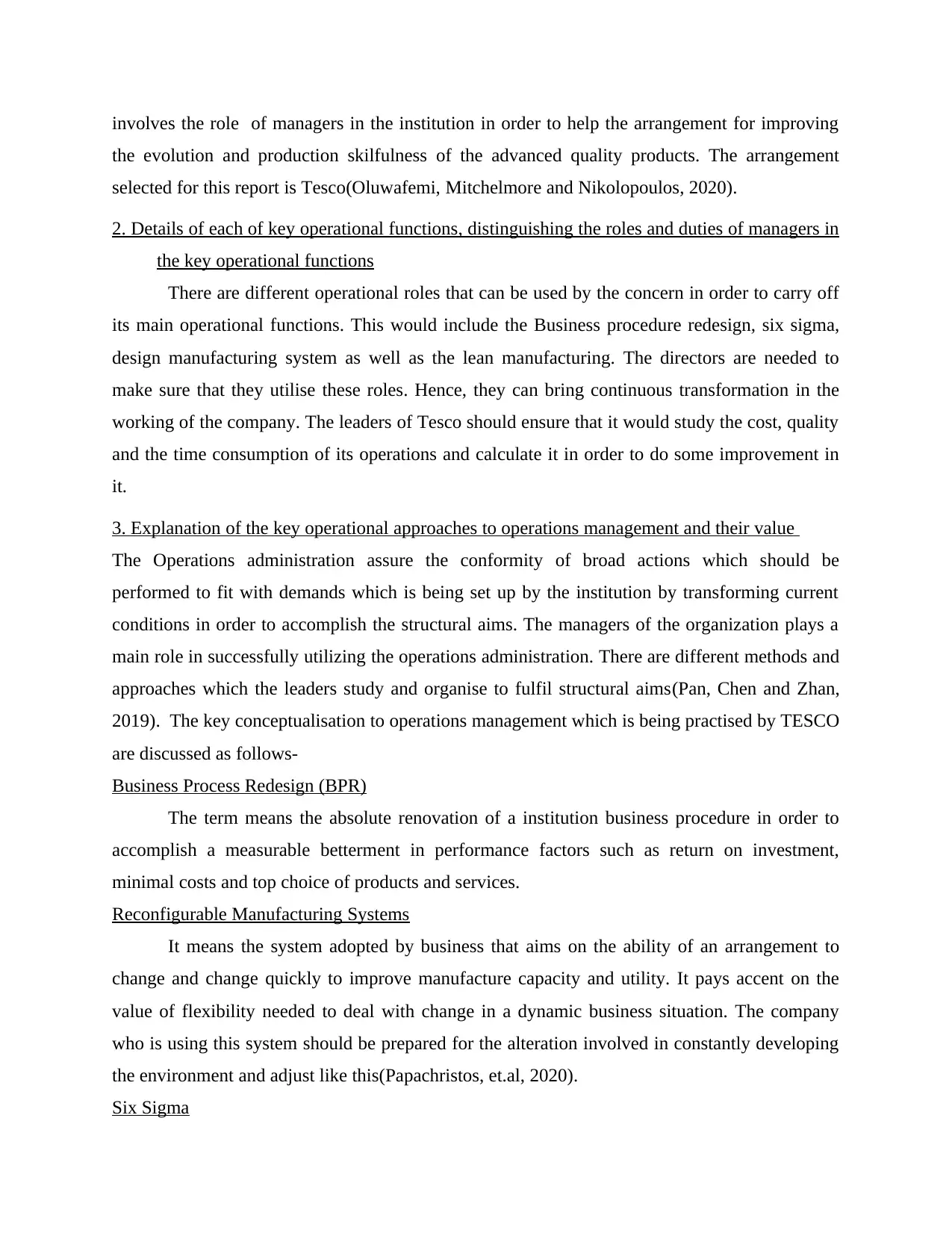
involves the role of managers in the institution in order to help the arrangement for improving
the evolution and production skilfulness of the advanced quality products. The arrangement
selected for this report is Tesco(Oluwafemi, Mitchelmore and Nikolopoulos, 2020).
2. Details of each of key operational functions, distinguishing the roles and duties of managers in
the key operational functions
There are different operational roles that can be used by the concern in order to carry off
its main operational functions. This would include the Business procedure redesign, six sigma,
design manufacturing system as well as the lean manufacturing. The directors are needed to
make sure that they utilise these roles. Hence, they can bring continuous transformation in the
working of the company. The leaders of Tesco should ensure that it would study the cost, quality
and the time consumption of its operations and calculate it in order to do some improvement in
it.
3. Explanation of the key operational approaches to operations management and their value
The Operations administration assure the conformity of broad actions which should be
performed to fit with demands which is being set up by the institution by transforming current
conditions in order to accomplish the structural aims. The managers of the organization plays a
main role in successfully utilizing the operations administration. There are different methods and
approaches which the leaders study and organise to fulfil structural aims(Pan, Chen and Zhan,
2019). The key conceptualisation to operations management which is being practised by TESCO
are discussed as follows-
Business Process Redesign (BPR)
The term means the absolute renovation of a institution business procedure in order to
accomplish a measurable betterment in performance factors such as return on investment,
minimal costs and top choice of products and services.
Reconfigurable Manufacturing Systems
It means the system adopted by business that aims on the ability of an arrangement to
change and change quickly to improve manufacture capacity and utility. It pays accent on the
value of flexibility needed to deal with change in a dynamic business situation. The company
who is using this system should be prepared for the alteration involved in constantly developing
the environment and adjust like this(Papachristos, et.al, 2020).
Six Sigma
the evolution and production skilfulness of the advanced quality products. The arrangement
selected for this report is Tesco(Oluwafemi, Mitchelmore and Nikolopoulos, 2020).
2. Details of each of key operational functions, distinguishing the roles and duties of managers in
the key operational functions
There are different operational roles that can be used by the concern in order to carry off
its main operational functions. This would include the Business procedure redesign, six sigma,
design manufacturing system as well as the lean manufacturing. The directors are needed to
make sure that they utilise these roles. Hence, they can bring continuous transformation in the
working of the company. The leaders of Tesco should ensure that it would study the cost, quality
and the time consumption of its operations and calculate it in order to do some improvement in
it.
3. Explanation of the key operational approaches to operations management and their value
The Operations administration assure the conformity of broad actions which should be
performed to fit with demands which is being set up by the institution by transforming current
conditions in order to accomplish the structural aims. The managers of the organization plays a
main role in successfully utilizing the operations administration. There are different methods and
approaches which the leaders study and organise to fulfil structural aims(Pan, Chen and Zhan,
2019). The key conceptualisation to operations management which is being practised by TESCO
are discussed as follows-
Business Process Redesign (BPR)
The term means the absolute renovation of a institution business procedure in order to
accomplish a measurable betterment in performance factors such as return on investment,
minimal costs and top choice of products and services.
Reconfigurable Manufacturing Systems
It means the system adopted by business that aims on the ability of an arrangement to
change and change quickly to improve manufacture capacity and utility. It pays accent on the
value of flexibility needed to deal with change in a dynamic business situation. The company
who is using this system should be prepared for the alteration involved in constantly developing
the environment and adjust like this(Papachristos, et.al, 2020).
Six Sigma
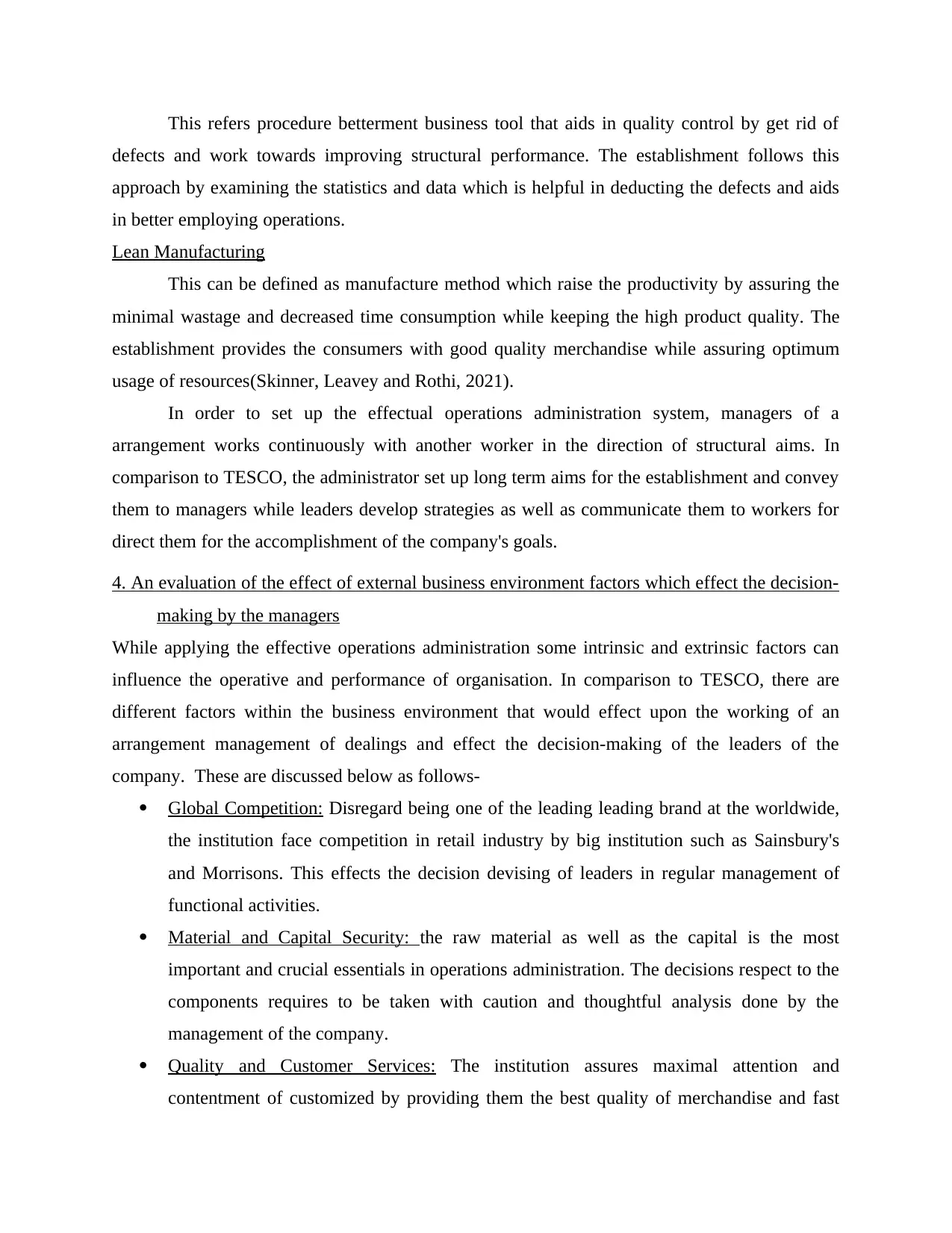
This refers procedure betterment business tool that aids in quality control by get rid of
defects and work towards improving structural performance. The establishment follows this
approach by examining the statistics and data which is helpful in deducting the defects and aids
in better employing operations.
Lean Manufacturing
This can be defined as manufacture method which raise the productivity by assuring the
minimal wastage and decreased time consumption while keeping the high product quality. The
establishment provides the consumers with good quality merchandise while assuring optimum
usage of resources(Skinner, Leavey and Rothi, 2021).
In order to set up the effectual operations administration system, managers of a
arrangement works continuously with another worker in the direction of structural aims. In
comparison to TESCO, the administrator set up long term aims for the establishment and convey
them to managers while leaders develop strategies as well as communicate them to workers for
direct them for the accomplishment of the company's goals.
4. An evaluation of the effect of external business environment factors which effect the decision-
making by the managers
While applying the effective operations administration some intrinsic and extrinsic factors can
influence the operative and performance of organisation. In comparison to TESCO, there are
different factors within the business environment that would effect upon the working of an
arrangement management of dealings and effect the decision-making of the leaders of the
company. These are discussed below as follows-
Global Competition: Disregard being one of the leading leading brand at the worldwide,
the institution face competition in retail industry by big institution such as Sainsbury's
and Morrisons. This effects the decision devising of leaders in regular management of
functional activities.
Material and Capital Security: the raw material as well as the capital is the most
important and crucial essentials in operations administration. The decisions respect to the
components requires to be taken with caution and thoughtful analysis done by the
management of the company.
Quality and Customer Services: The institution assures maximal attention and
contentment of customized by providing them the best quality of merchandise and fast
defects and work towards improving structural performance. The establishment follows this
approach by examining the statistics and data which is helpful in deducting the defects and aids
in better employing operations.
Lean Manufacturing
This can be defined as manufacture method which raise the productivity by assuring the
minimal wastage and decreased time consumption while keeping the high product quality. The
establishment provides the consumers with good quality merchandise while assuring optimum
usage of resources(Skinner, Leavey and Rothi, 2021).
In order to set up the effectual operations administration system, managers of a
arrangement works continuously with another worker in the direction of structural aims. In
comparison to TESCO, the administrator set up long term aims for the establishment and convey
them to managers while leaders develop strategies as well as communicate them to workers for
direct them for the accomplishment of the company's goals.
4. An evaluation of the effect of external business environment factors which effect the decision-
making by the managers
While applying the effective operations administration some intrinsic and extrinsic factors can
influence the operative and performance of organisation. In comparison to TESCO, there are
different factors within the business environment that would effect upon the working of an
arrangement management of dealings and effect the decision-making of the leaders of the
company. These are discussed below as follows-
Global Competition: Disregard being one of the leading leading brand at the worldwide,
the institution face competition in retail industry by big institution such as Sainsbury's
and Morrisons. This effects the decision devising of leaders in regular management of
functional activities.
Material and Capital Security: the raw material as well as the capital is the most
important and crucial essentials in operations administration. The decisions respect to the
components requires to be taken with caution and thoughtful analysis done by the
management of the company.
Quality and Customer Services: The institution assures maximal attention and
contentment of customized by providing them the best quality of merchandise and fast
⊘ This is a preview!⊘
Do you want full access?
Subscribe today to unlock all pages.

Trusted by 1+ million students worldwide
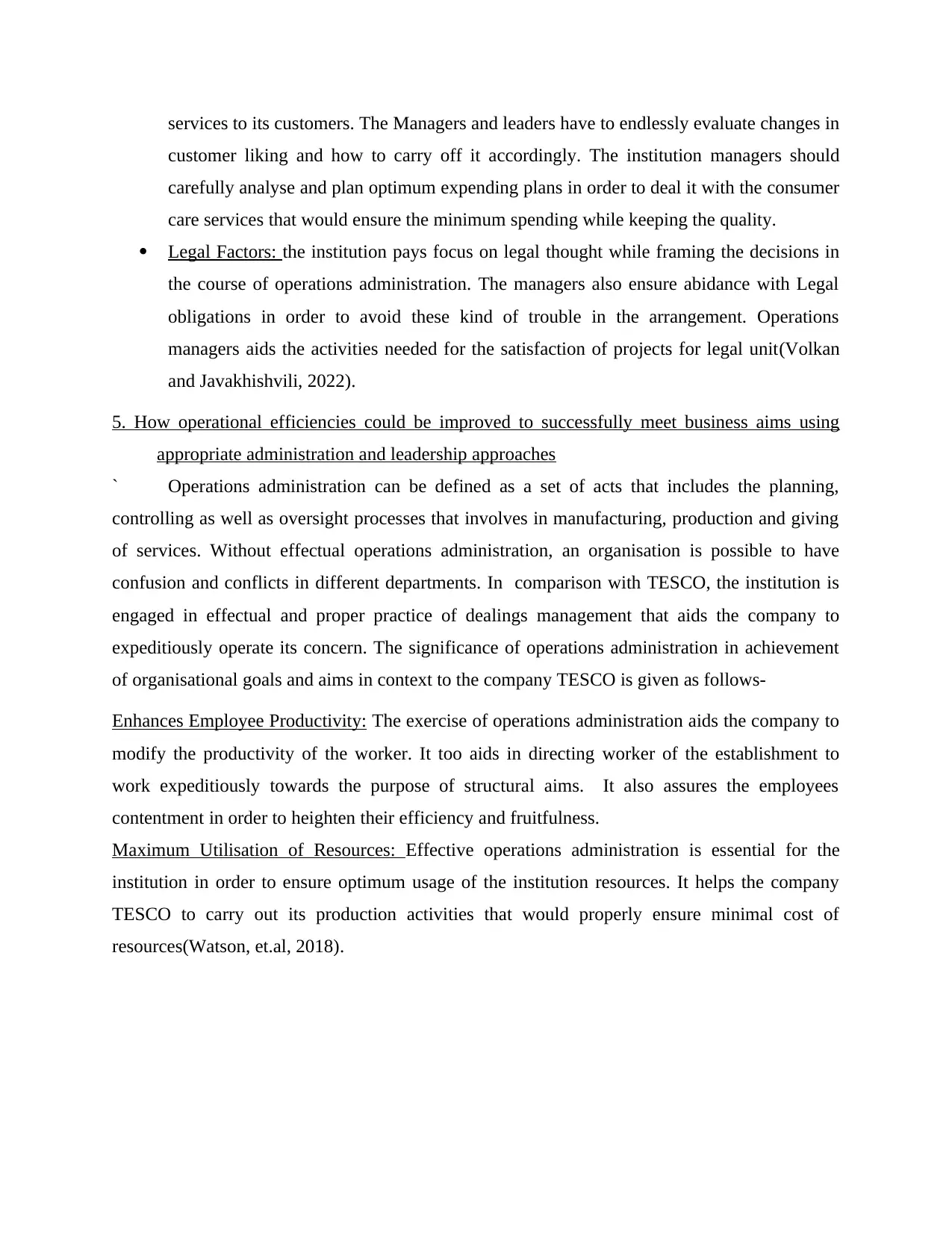
services to its customers. The Managers and leaders have to endlessly evaluate changes in
customer liking and how to carry off it accordingly. The institution managers should
carefully analyse and plan optimum expending plans in order to deal it with the consumer
care services that would ensure the minimum spending while keeping the quality.
Legal Factors: the institution pays focus on legal thought while framing the decisions in
the course of operations administration. The managers also ensure abidance with Legal
obligations in order to avoid these kind of trouble in the arrangement. Operations
managers aids the activities needed for the satisfaction of projects for legal unit(Volkan
and Javakhishvili, 2022).
5. How operational efficiencies could be improved to successfully meet business aims using
appropriate administration and leadership approaches
` Operations administration can be defined as a set of acts that includes the planning,
controlling as well as oversight processes that involves in manufacturing, production and giving
of services. Without effectual operations administration, an organisation is possible to have
confusion and conflicts in different departments. In comparison with TESCO, the institution is
engaged in effectual and proper practice of dealings management that aids the company to
expeditiously operate its concern. The significance of operations administration in achievement
of organisational goals and aims in context to the company TESCO is given as follows-
Enhances Employee Productivity: The exercise of operations administration aids the company to
modify the productivity of the worker. It too aids in directing worker of the establishment to
work expeditiously towards the purpose of structural aims. It also assures the employees
contentment in order to heighten their efficiency and fruitfulness.
Maximum Utilisation of Resources: Effective operations administration is essential for the
institution in order to ensure optimum usage of the institution resources. It helps the company
TESCO to carry out its production activities that would properly ensure minimal cost of
resources(Watson, et.al, 2018).
customer liking and how to carry off it accordingly. The institution managers should
carefully analyse and plan optimum expending plans in order to deal it with the consumer
care services that would ensure the minimum spending while keeping the quality.
Legal Factors: the institution pays focus on legal thought while framing the decisions in
the course of operations administration. The managers also ensure abidance with Legal
obligations in order to avoid these kind of trouble in the arrangement. Operations
managers aids the activities needed for the satisfaction of projects for legal unit(Volkan
and Javakhishvili, 2022).
5. How operational efficiencies could be improved to successfully meet business aims using
appropriate administration and leadership approaches
` Operations administration can be defined as a set of acts that includes the planning,
controlling as well as oversight processes that involves in manufacturing, production and giving
of services. Without effectual operations administration, an organisation is possible to have
confusion and conflicts in different departments. In comparison with TESCO, the institution is
engaged in effectual and proper practice of dealings management that aids the company to
expeditiously operate its concern. The significance of operations administration in achievement
of organisational goals and aims in context to the company TESCO is given as follows-
Enhances Employee Productivity: The exercise of operations administration aids the company to
modify the productivity of the worker. It too aids in directing worker of the establishment to
work expeditiously towards the purpose of structural aims. It also assures the employees
contentment in order to heighten their efficiency and fruitfulness.
Maximum Utilisation of Resources: Effective operations administration is essential for the
institution in order to ensure optimum usage of the institution resources. It helps the company
TESCO to carry out its production activities that would properly ensure minimal cost of
resources(Watson, et.al, 2018).
Paraphrase This Document
Need a fresh take? Get an instant paraphrase of this document with our AI Paraphraser
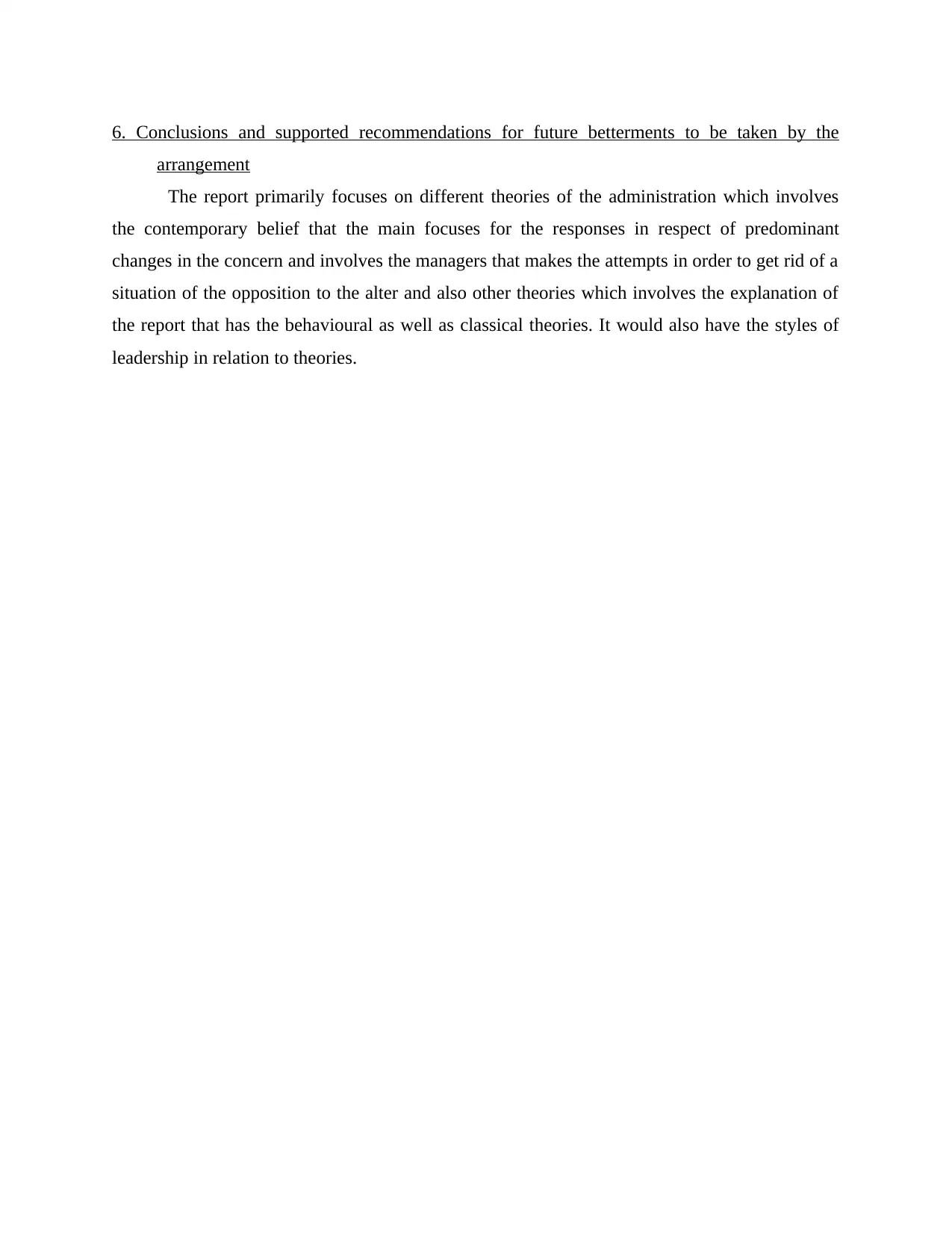
6. Conclusions and supported recommendations for future betterments to be taken by the
arrangement
The report primarily focuses on different theories of the administration which involves
the contemporary belief that the main focuses for the responses in respect of predominant
changes in the concern and involves the managers that makes the attempts in order to get rid of a
situation of the opposition to the alter and also other theories which involves the explanation of
the report that has the behavioural as well as classical theories. It would also have the styles of
leadership in relation to theories.
arrangement
The report primarily focuses on different theories of the administration which involves
the contemporary belief that the main focuses for the responses in respect of predominant
changes in the concern and involves the managers that makes the attempts in order to get rid of a
situation of the opposition to the alter and also other theories which involves the explanation of
the report that has the behavioural as well as classical theories. It would also have the styles of
leadership in relation to theories.
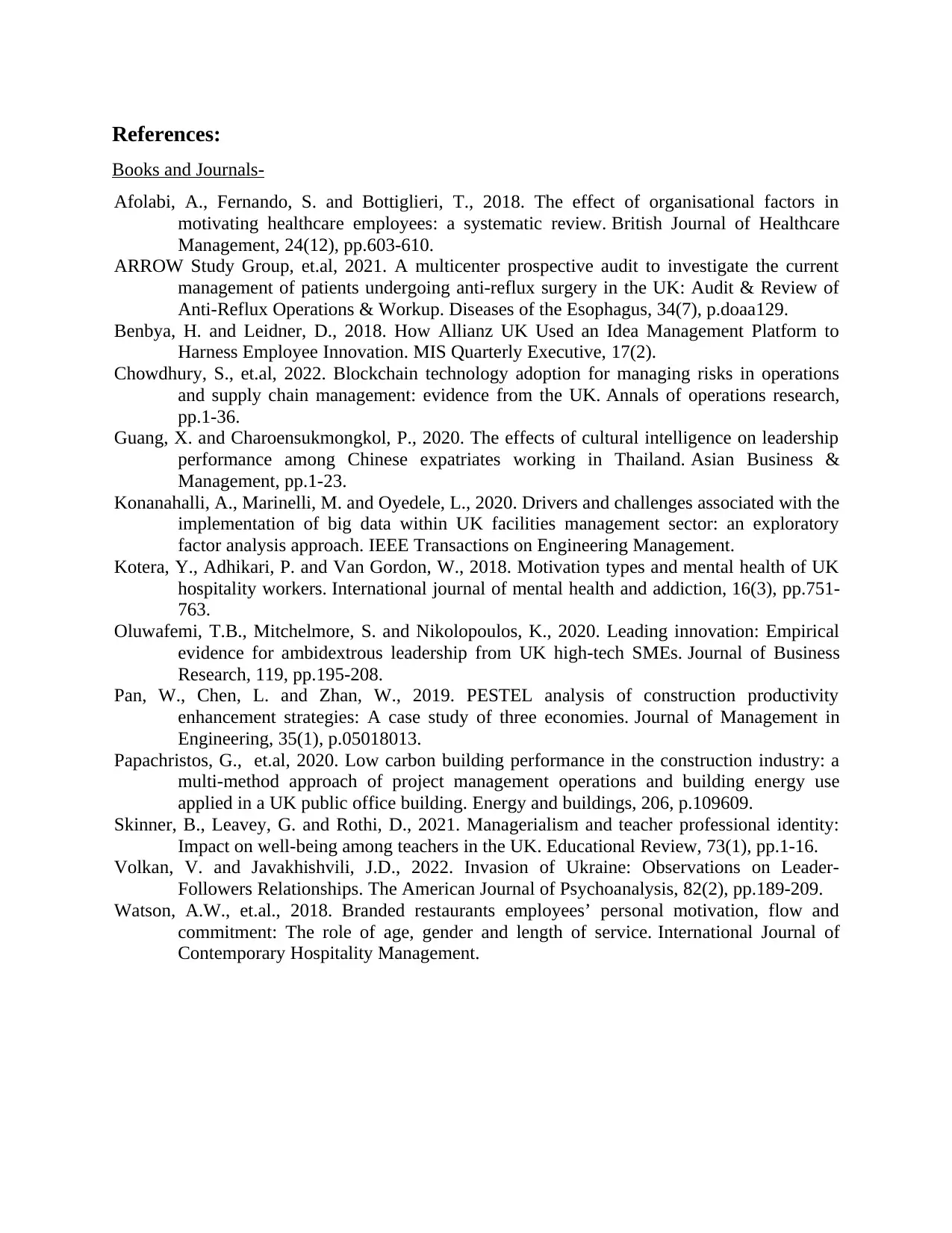
References:
Books and Journals-
Afolabi, A., Fernando, S. and Bottiglieri, T., 2018. The effect of organisational factors in
motivating healthcare employees: a systematic review. British Journal of Healthcare
Management, 24(12), pp.603-610.
ARROW Study Group, et.al, 2021. A multicenter prospective audit to investigate the current
management of patients undergoing anti-reflux surgery in the UK: Audit & Review of
Anti-Reflux Operations & Workup. Diseases of the Esophagus, 34(7), p.doaa129.
Benbya, H. and Leidner, D., 2018. How Allianz UK Used an Idea Management Platform to
Harness Employee Innovation. MIS Quarterly Executive, 17(2).
Chowdhury, S., et.al, 2022. Blockchain technology adoption for managing risks in operations
and supply chain management: evidence from the UK. Annals of operations research,
pp.1-36.
Guang, X. and Charoensukmongkol, P., 2020. The effects of cultural intelligence on leadership
performance among Chinese expatriates working in Thailand. Asian Business &
Management, pp.1-23.
Konanahalli, A., Marinelli, M. and Oyedele, L., 2020. Drivers and challenges associated with the
implementation of big data within UK facilities management sector: an exploratory
factor analysis approach. IEEE Transactions on Engineering Management.
Kotera, Y., Adhikari, P. and Van Gordon, W., 2018. Motivation types and mental health of UK
hospitality workers. International journal of mental health and addiction, 16(3), pp.751-
763.
Oluwafemi, T.B., Mitchelmore, S. and Nikolopoulos, K., 2020. Leading innovation: Empirical
evidence for ambidextrous leadership from UK high-tech SMEs. Journal of Business
Research, 119, pp.195-208.
Pan, W., Chen, L. and Zhan, W., 2019. PESTEL analysis of construction productivity
enhancement strategies: A case study of three economies. Journal of Management in
Engineering, 35(1), p.05018013.
Papachristos, G., et.al, 2020. Low carbon building performance in the construction industry: a
multi-method approach of project management operations and building energy use
applied in a UK public office building. Energy and buildings, 206, p.109609.
Skinner, B., Leavey, G. and Rothi, D., 2021. Managerialism and teacher professional identity:
Impact on well-being among teachers in the UK. Educational Review, 73(1), pp.1-16.
Volkan, V. and Javakhishvili, J.D., 2022. Invasion of Ukraine: Observations on Leader-
Followers Relationships. The American Journal of Psychoanalysis, 82(2), pp.189-209.
Watson, A.W., et.al., 2018. Branded restaurants employees’ personal motivation, flow and
commitment: The role of age, gender and length of service. International Journal of
Contemporary Hospitality Management.
Books and Journals-
Afolabi, A., Fernando, S. and Bottiglieri, T., 2018. The effect of organisational factors in
motivating healthcare employees: a systematic review. British Journal of Healthcare
Management, 24(12), pp.603-610.
ARROW Study Group, et.al, 2021. A multicenter prospective audit to investigate the current
management of patients undergoing anti-reflux surgery in the UK: Audit & Review of
Anti-Reflux Operations & Workup. Diseases of the Esophagus, 34(7), p.doaa129.
Benbya, H. and Leidner, D., 2018. How Allianz UK Used an Idea Management Platform to
Harness Employee Innovation. MIS Quarterly Executive, 17(2).
Chowdhury, S., et.al, 2022. Blockchain technology adoption for managing risks in operations
and supply chain management: evidence from the UK. Annals of operations research,
pp.1-36.
Guang, X. and Charoensukmongkol, P., 2020. The effects of cultural intelligence on leadership
performance among Chinese expatriates working in Thailand. Asian Business &
Management, pp.1-23.
Konanahalli, A., Marinelli, M. and Oyedele, L., 2020. Drivers and challenges associated with the
implementation of big data within UK facilities management sector: an exploratory
factor analysis approach. IEEE Transactions on Engineering Management.
Kotera, Y., Adhikari, P. and Van Gordon, W., 2018. Motivation types and mental health of UK
hospitality workers. International journal of mental health and addiction, 16(3), pp.751-
763.
Oluwafemi, T.B., Mitchelmore, S. and Nikolopoulos, K., 2020. Leading innovation: Empirical
evidence for ambidextrous leadership from UK high-tech SMEs. Journal of Business
Research, 119, pp.195-208.
Pan, W., Chen, L. and Zhan, W., 2019. PESTEL analysis of construction productivity
enhancement strategies: A case study of three economies. Journal of Management in
Engineering, 35(1), p.05018013.
Papachristos, G., et.al, 2020. Low carbon building performance in the construction industry: a
multi-method approach of project management operations and building energy use
applied in a UK public office building. Energy and buildings, 206, p.109609.
Skinner, B., Leavey, G. and Rothi, D., 2021. Managerialism and teacher professional identity:
Impact on well-being among teachers in the UK. Educational Review, 73(1), pp.1-16.
Volkan, V. and Javakhishvili, J.D., 2022. Invasion of Ukraine: Observations on Leader-
Followers Relationships. The American Journal of Psychoanalysis, 82(2), pp.189-209.
Watson, A.W., et.al., 2018. Branded restaurants employees’ personal motivation, flow and
commitment: The role of age, gender and length of service. International Journal of
Contemporary Hospitality Management.
⊘ This is a preview!⊘
Do you want full access?
Subscribe today to unlock all pages.

Trusted by 1+ million students worldwide
1 out of 12
Related Documents
Your All-in-One AI-Powered Toolkit for Academic Success.
+13062052269
info@desklib.com
Available 24*7 on WhatsApp / Email
![[object Object]](/_next/static/media/star-bottom.7253800d.svg)
Unlock your academic potential
Copyright © 2020–2025 A2Z Services. All Rights Reserved. Developed and managed by ZUCOL.





